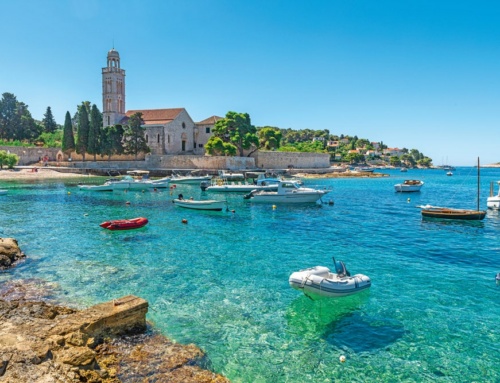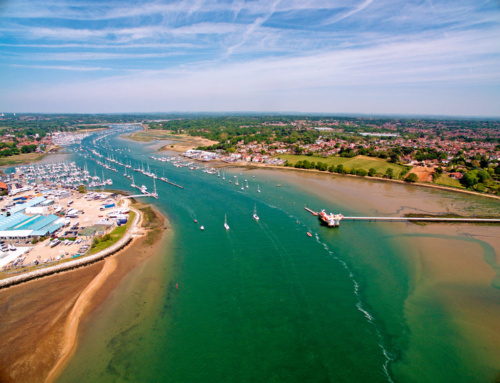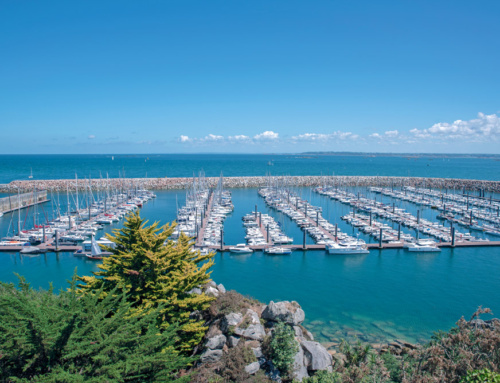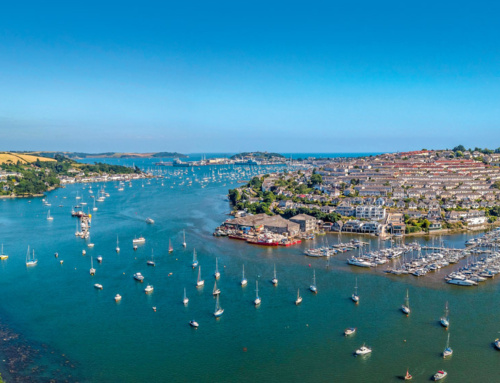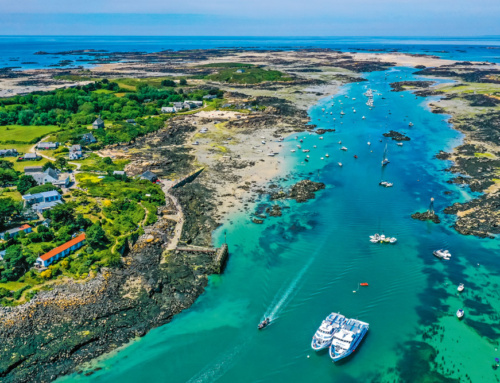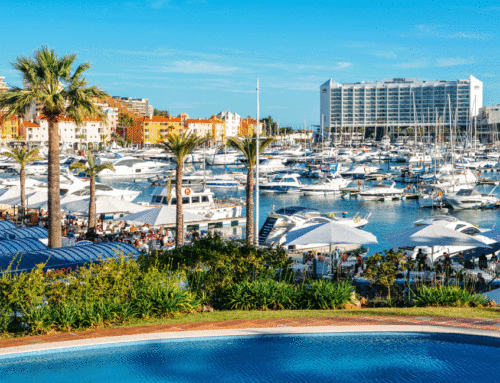- Falmouth Harbour is a great holiday location whose sheltered position makes it a safe bet with the windy summers we now get.
- For the water sports fanatic, it is a no-brainer.
- It is a popular location but never really seems overcrowded, especially on the water.
Greg Copp shares with PBR readers his experience and knowledge of Falmouth Harbour and the surrounding area …
I first sampled Falmouth Harbour 27 years ago during a camping trip to Cornwall’s northern coast. I had a 13ft dory in tow, which I soon found unsuited to the tempestuous ‘Wreckers coast’. A friend wisely suggested we took a trip down to Falmouth, where life would be saner. The next day, 10 of us and my two dogs were looking at Mylor Yacht Harbour at low water. Thirty minutes later, after lifting my boat off the trailer and dragging it across 100 yards of knee-high mud, we were afloat.
Of course, back then there was no RCD rating to advise me that 10 people and two hounds might be too much for my dory. Regardless, we chugged off through the moorings heading north until we found one of the many small beaches that exist at low water. With the payload disgorged to soak up the sun, three of us set off to explore and waterski in the nearby designated area. What struck me was the tranquil timeless character of this unusual inland waterway.
Today it is still just as appealing, and just as timeless. For several summers I have been trailering RIBs down to Falmouth, but this year, having sold my last RIB, I took a different approach. As I like a bit of snorkelling, and wanted to be able to get up some shallow creeks, I looked around for a big inflatable. I soon found a pristine 4.5m Wetline 450HD on a refurbished trailer for £750 on eBay. The moment I saw it I could not part with my money fast enough. All I then had to do was find a second-hand 25hp or 30hp Yamaha 2-stroke outboard for it. Then it occurred to me that Yamaha had just launched their new F25G. Weighing just 57kg in tiller form, it is the only 4-stroke in its class to compete with the 50kg 25hp 2-stroke motors that EU legislation banished in 2006. Yamaha were happy to supply one for a long-term test, and the moment I clapped eyes on it I realised just how perfect it is for the lightweight tender/RIB market. In ‘Boat Tech’ you can read further how it fared during its first run out.
Every cruise needs a base, and for Falmouth you can’t beat Mylor Yacht Harbour. There are various other tucked-away locations around the harbour, not to mention Falmouth itself. However, Mylor Yacht Harbour located at the mouth of Mylor Creek has a laid-back charm that I have not found elsewhere, not to mention a fantastic harbour view. Though there is a waiting list for a permanent berth, they do offer an excellent dry-berthing package (most sizes), giving you 10 launches/recoveries, with a visitor’s berth while afloat. This, like the holiday apartments they have around the marina, is aimed at tempting people like me to make a West Country pilgrimage. The yacht harbour also has good facilities, with a chandler, a variety of marine services, full tidal access, two large slipways and two waterfront cafes, one of which is licensed.
I always rent a cottage from Creekside Cottages – in this case on Restronguet Creek, importantly a short walk from the well-known Pandora Inn. As it has its own pontoon, this 13th century watering hole gets a big share of waterborne visitors. It also offers a good range of well-kept ale, a decent selection of wine and great food. During the summer holidays it is busy – but capable of dealing with the demand. Restronguet Creek’s character, especially if you are used to the hustle of South-East boating, is surreal. There are several moorings (some available for Creekside Cottage tenants), small forgotten boatyards, secret smuggler-like pontoons, tiny beaches and boathouses, and all surrounded by interesting but very expensive houses. Various craft creep in and out of the creek at all times of day, but not at all states of the tide. If you want to go further up the creek to the waterfront villages of Penpol and Devoran, where the Old Quay Inn on the waterfront is worth visiting, you will need some tide, as pretty much all of this area dries at low water. There are narrow channels but they are unmarked, and still not navigable at low water. Even Pandora’s pontoon dries to just under 1m at LWS, which some people overcome by mooring on a vacant buoy and then canoeing ashore.
Outside of the forgotten world of Restronguet Creek, life in Falmouth Harbour can take on a livelier character. Entering the wide mouth of the harbour, built by Henry VIII in 1542, you have Pendennis Castle to the west. This formidable artillery battery has kept the Spanish and French at bay for centuries, and by the Napoleonic Wars of the early 19th century it housed 48 heavy 42-pounder cannons, capable of turning even the biggest ships of the line into smoking wrecks. The eastern side of the entrance is marked by the lighthouse on St Anthony’s Head, whose light is visible out to 16 miles to the south and south-west. Just inside the harbour, on the eastern side, there are some small forgotten beaches that are favourites of mine – in the area known as Little Molunan. They increase in size considerably at low water, and are only used by those with boats or those prepared to walk some distance. They are often deserted and ideal if things are rough outside the harbour, though strong south-westerlies will take their toll on them.
Moving north, St Mawes Harbour on the eastern side is the first port of call. Guarded by another, smaller artillery fort at Castle Point, this waterway is a network of moorings through which you must thread to reach St Mawes itself. This small waterfront town connects to Falmouth via two ferries, and is a popular spot for those in small boats wishing to land at the pontoon or drying beach inside the breakwater to take advantage of a small selection of waterfront eateries. Tide-dependent, there is also a ferry route across the moorings to Place Creek, on the Roseland Peninsula. At high water, this is a good location for canoeing and swimming, being totally sheltered from any weather. Should you choose, you can head further north-east from St Mawes to the various creeks that exist upstream. One particular place of interest is Percuil Boatyard, which, with its slipway, moorings and chandlery, is off the beaten track and pretty much the last landing point before things dry out at low water. You can venture further for another mile or so beyond Percuil, but you will need to do your tidal calculations.
The main body of the harbour from its entrance up to Turnaware Point, where it narrows, is known as Carrick Roads. Outside of the moorings there is no speed limit in this large area, and on the eastern side of the harbour there are two waterski areas – one south and one north of St Just Creek. If you are keen on your water sports, then Falmouth Harbour is a safe bet when it comes to the weather, as both these sections are normally calm in all but the worst weather. Carrick Roads and the narrow neck north of it have an unusually deep passage that winds its way north. It threads past the King Harry Ferry until it reaches the junction of the Truro and Fal rivers. Consequently you can find, as I did, large commercial ships anchored and forgotten in the narrower confines north of the ferry crossing.
Before you venture north beyond Turnaware Point, St Just Creek is worth a look. Like St Mawes, it hosts a selection of mooring buoys, as well as being ably served by Pasco’s Boatyard. St Just itself is a pretty location that offers an alternative venue, especially if you want to stay on the eastern side of the harbour.
As soon as you pass Turnaware, there is an 8-knot speed limit. Creeping north, the true sleepy nature of the harbour makes itself felt. The treeline comes down to the water in most places, and various mini creeks open up as you pass them, some with ad hoc moorings for hidden houses. Channals Creek on the west bank is a picturesque mooring spot, with its own beach and distant manor house. There are also various pontoon moorings here and there, but none as unique as Smugglers Moorings. Located on the east bank north of the King Harry Ferry, Smugglers Moorings is a mini marina, complete with slipway, pontoon and mooring buoys, for members and visitors alike. Visited by General Eisenhower during WWII, it was one of the launching points for US forces on D-Day. Few places this far inland in such narrow waters have such depth, hence this 500-year-old settlement has been playing its part for centuries.
After Smugglers you come to the junction of the Fal and Truro rivers. The Fal dries pretty much its entire length at low water. There is a channel but it is not marked; however, with a small, shallow-draught boat you should be able to get up it two hours either side of high water. There are no real destinations as such on the Fal, just a few wooded creeks. Pushing up the Truro river you come across an old disused dock, whose partially restored building would have served the old quarry that sits forgotten in the woods behind.
The last realistic upstream destination is Malpas. What I like about Malpas is that as you round the curve in the river, its high, prominent waterfront buildings give the impression of a centre of civilisation in a wooded wilderness. Malpas Marine, like Smugglers, is a mini marina, and has quite a few facilities to support it. Though the few members’ moorings – pontoon and buoy – are inevitably taken, there are offshore visitors’ pontoons with full tidal access, for which you will need a tender. The western side of Malpas has a long private pontoon, which belongs to the lucky few of Victoria Quay.
At Malpas you can either turn north-east up the Tresillian river or north-west up the last stretch of the Truro river. The Tresillian river dries most of its length at low water and has no marked channel. Apart from some private moorings it has no real destinations. The last true destination is, of course, Truro, which has a marked channel all the way up to the A390 bridge. However, after turning the corner at Malpas, it soon dries at low water, so if you take the channel up to Truro you will need to get the tide right. On the way up, there are drying private mooring buoys on the riverbank, but, to be fair, little to look at. You can tie up against the wall by the A390 bridge, and some are meant to be visitors’ moorings, but when I have driven past I have always seen them full.
Falmouth Harbour is a great holiday location whose sheltered position makes it a safe bet with the windy summers we now get. For the water sports fanatic, it is a no-brainer. It is a popular location but never really seems overcrowded, especially on the water. With a larger boat it is perfectly located for pushing further afield to the superb sandy beaches on Cornwall’s spectacular coastline, or even the white-sand Caribbean-like beaches of the Scillies.
Falmouth and Flushing
Falmouth and Flushing, sitting on opposite sides of the Penryn river mouth, need a specific mention. Falmouth usually has the odd warship along with some commercial shipping tucked away in the docks. It also has two prominent marinas: Port Pendennis and Premier’s marina at the entrance to the Penryn River, both with full tidal access. Between the two there are other berthing facilities, notably Falmouth Watersports Centre, a stone’s throw from Pendennis Marina, which has a great park-and-launch facility, as well as the biggest full tidal access slipway in the harbour. There are other marine facilities, chandlers and boatyards nearer the Penryn river mouth.
For many, the biggest appeal of Falmouth and Flushing is what they offer in terms of entertainment. Sitting just across the water, Flushing is a charming waterfront village accessed by one narrow street. I have stayed here overlooking the water in the past, and love it. However, do not entertain towing a boat through it, unless it is the dead of night. It has two great pubs, with good beer and great-value food, as well as a small waterfront restaurant. What I like about Flushing is that you can live in its silent forgotten streets and then venture across the water to Falmouth for a night out, courtesy of a regular ferry service. This concept works for other places like St Mawes, though you will not want to miss the last boat back as it is a long and costly cab ride around the harbour. A great night out is to start at the Pandora Inn, and then take a water taxi (I have even seen a fast RIB taxi for this) round to Falmouth. Alighting at the Prince of Wales Pier, there are many great waterfront pubs, often hosting bands. My favourite location is Gurkha Falmouth, a Nepalese and Indian restaurant just a short stroll from the pier up Killigrew Street. It does a first-rate curry and there is even a taxi rank outside to whisk you home afterwards.


